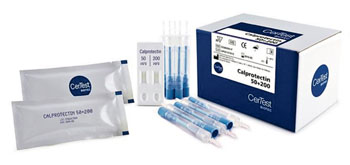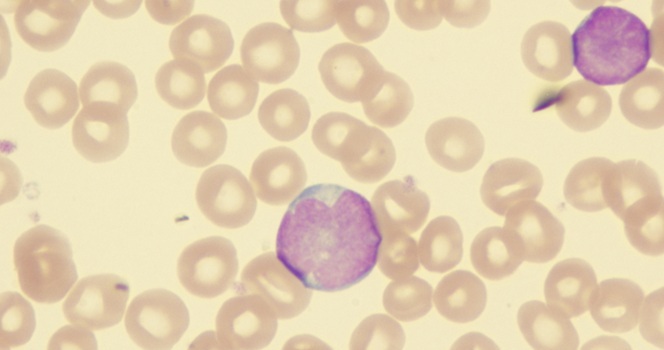Sensitive Clinical Marker Defined for Ulcerative Colitis Evolution
|
By LabMedica International staff writers Posted on 20 Sep 2016 |

Image: The semi-quantitative Calprotectin 50 + 200 combo card test (Photo courtesy of CerTest Biotec).
The two main subtypes of inflammatory bowel diseases (IBD), Crohn’s disease (CD) and ulcerative colitis (UC) are characterized by episodes of inflammatory activity and remission and determination of disease activity remains challenging, with most clinical scores correlating poorly with the inflammatory state.
Treatment of IBD patients has recently shifted from controlling symptoms to promoting endoscopic mucosal healing or deep remission and treatment promoting mucosal healing can slow the progression of the disease. In this context, laboratory biomarkers have gained importance in evaluating and predicting the response to therapy.
Scientists at the University of Chile (Santiago, Chile) prospectively recruited 26 patients grouped according to an endoscopic score and therapy response. Colonoscopic biopsies were collected at baseline and six months or when patients showed clinical activity. The protocol was reinitiated in patients requiring rescue therapy. Blood and stool were collected at baseline, one, three, six and 12 months.
Serum and intestinal ST2 (Interleukin 1 receptor-like 1) concentrations, as well as serum interleukin -33 (IL-33) levels were measured using an enzyme-linked immunosorbent assay (ELISA) kit for human ST2 or IL-33 (DuoSet, R&D Systems, Minneapolis, MN, USA). The ST2 detection assay is stable over time, with a detection limit of 20 pg/mL, while the IL-33 detection assay is less stable over time, with a detection limit of 23.4 pg/mL. The supernatant from the fecal samples were processed for the rapid semi-quantitative test Calprotectin 50+200 (CerTest Biotec S.L., Zaragoza, Spain). Mucosal ST2 detection was performed by immunofluorescence and the images captured using an Olympus confocal laser scanning biological microscope FV10i (Olympus America Inc., Melville, NY, USA).
The team reported that follow-up was completed in 24 patients. The statistically significant median and range of soluble sST2 levels varied from 173.5 pg/mL (136.6–274.0) to 86.5 pg/mL (54.6–133.2) in responders and 336.3 pg/mL (211.0–403.2) to 385.3 pg/mL (283.4–517.3) in non-responders at baseline and six months respectively. Soluble sST2 levels correlated with Mayo clinical and endoscopic subscore, mucosal ST2 and fecal calprotectin (FC) and showed a trend similar to that of FC in responders. Non-responders revealed an increased ST2 content, restricted to the lamina propria’s cellular infiltrate.
The authors concluded that during the follow-up, serial ST2 measurements decreased in those patients with a reduced endoscopic index at six months, indicating a positive response to therapy. In those patients, FC levels were also significantly decreased in direct correlation to sST2 levels. The accuracy of sST2 in endoscopic detection of UC strongly suggests its usefulness in monitoring relapse and outcome, as well as in identifying patients likely to benefit from a particular treatment. The study was published on August 28, 2016, in the journal BMC Gastroenterology.
Related Links:
University of Chile
R&D Systems
CerTest Biotec
Olympus America
Treatment of IBD patients has recently shifted from controlling symptoms to promoting endoscopic mucosal healing or deep remission and treatment promoting mucosal healing can slow the progression of the disease. In this context, laboratory biomarkers have gained importance in evaluating and predicting the response to therapy.
Scientists at the University of Chile (Santiago, Chile) prospectively recruited 26 patients grouped according to an endoscopic score and therapy response. Colonoscopic biopsies were collected at baseline and six months or when patients showed clinical activity. The protocol was reinitiated in patients requiring rescue therapy. Blood and stool were collected at baseline, one, three, six and 12 months.
Serum and intestinal ST2 (Interleukin 1 receptor-like 1) concentrations, as well as serum interleukin -33 (IL-33) levels were measured using an enzyme-linked immunosorbent assay (ELISA) kit for human ST2 or IL-33 (DuoSet, R&D Systems, Minneapolis, MN, USA). The ST2 detection assay is stable over time, with a detection limit of 20 pg/mL, while the IL-33 detection assay is less stable over time, with a detection limit of 23.4 pg/mL. The supernatant from the fecal samples were processed for the rapid semi-quantitative test Calprotectin 50+200 (CerTest Biotec S.L., Zaragoza, Spain). Mucosal ST2 detection was performed by immunofluorescence and the images captured using an Olympus confocal laser scanning biological microscope FV10i (Olympus America Inc., Melville, NY, USA).
The team reported that follow-up was completed in 24 patients. The statistically significant median and range of soluble sST2 levels varied from 173.5 pg/mL (136.6–274.0) to 86.5 pg/mL (54.6–133.2) in responders and 336.3 pg/mL (211.0–403.2) to 385.3 pg/mL (283.4–517.3) in non-responders at baseline and six months respectively. Soluble sST2 levels correlated with Mayo clinical and endoscopic subscore, mucosal ST2 and fecal calprotectin (FC) and showed a trend similar to that of FC in responders. Non-responders revealed an increased ST2 content, restricted to the lamina propria’s cellular infiltrate.
The authors concluded that during the follow-up, serial ST2 measurements decreased in those patients with a reduced endoscopic index at six months, indicating a positive response to therapy. In those patients, FC levels were also significantly decreased in direct correlation to sST2 levels. The accuracy of sST2 in endoscopic detection of UC strongly suggests its usefulness in monitoring relapse and outcome, as well as in identifying patients likely to benefit from a particular treatment. The study was published on August 28, 2016, in the journal BMC Gastroenterology.
Related Links:
University of Chile
R&D Systems
CerTest Biotec
Olympus America
Latest Immunology News
- New Test Distinguishes Vaccine-Induced False Positives from Active HIV Infection
- Gene Signature Test Predicts Response to Key Breast Cancer Treatment
- Chip Captures Cancer Cells from Blood to Help Select Right Breast Cancer Treatment
- Blood-Based Liquid Biopsy Model Analyzes Immunotherapy Effectiveness
- Signature Genes Predict T-Cell Expansion in Cancer Immunotherapy
- Molecular Microscope Diagnostic System Assesses Lung Transplant Rejection
- Blood Test Tracks Treatment Resistance in High-Grade Serous Ovarian Cancer
- Luminescent Probe Measures Immune Cell Activity in Real Time
- Blood-Based Immune Cell Signatures Could Guide Treatment Decisions for Critically Ill Patients
- Novel Tool Predicts Most Effective Multiple Sclerosis Medication for Patients
- Companion Diagnostic Test for CRC Patients Identifies Eligible Treatment Population
- Novel Tool Uses Deep Learning for Precision Cancer Therapy
- Companion Diagnostic Test Identifies HER2-Ultralow Breast Cancer and Biliary Tract Cancer Patients
- Novel Multiplex Assay Supports Diagnosis of Autoimmune Vasculitis
- Blood Test Predicts Immunotherapy Efficacy in Triple-Negative Breast Cancer
- Simple Genetic Testing Could Predict Treatment Success in Multiple Sclerosis Patients
Channels
Clinical Chemistry
view channel
Chemical Imaging Probe Could Track and Treat Prostate Cancer
Prostate cancer remains a leading cause of illness and death among men, with many patients eventually developing resistance to standard hormone-blocking therapies. These drugs often lose effectiveness... Read more
Mismatch Between Two Common Kidney Function Tests Indicates Serious Health Problems
Creatinine has long been the standard for measuring kidney filtration, while cystatin C — a protein produced by all human cells — has been recommended as a complementary marker because it is influenced... Read moreMolecular Diagnostics
view channel
New Blood Biomarkers Help Diagnose Pregnancy-Linked Liver Complication
Intrahepatic cholestasis of pregnancy (ICP) is the most common liver disorder linked to pregnancy and can pose serious risks for both mother and baby, including premature delivery and stillbirth.... Read more
Simple Urine Test to Revolutionize Bladder Cancer Diagnosis and Treatment
Bladder cancer is one of the most common and deadly urological cancers and is marked by a high rate of recurrence. Diagnosis and follow-up still rely heavily on invasive cystoscopy or urine cytology, which... Read moreHematology
view channel
MRD Tests Could Predict Survival in Leukemia Patients
Acute myeloid leukemia is an aggressive blood cancer that disrupts normal blood cell production and often relapses even after intensive treatment. Clinicians currently lack early, reliable markers to predict... Read more
Platelet Activity Blood Test in Middle Age Could Identify Early Alzheimer’s Risk
Early detection of Alzheimer’s disease remains one of the biggest unmet needs in neurology, particularly because the biological changes underlying the disorder begin decades before memory symptoms appear.... Read more
Microvesicles Measurement Could Detect Vascular Injury in Sickle Cell Disease Patients
Assessing disease severity in sickle cell disease (SCD) remains challenging, especially when trying to predict hemolysis, vascular injury, and risk of complications such as vaso-occlusive crises.... Read more
ADLM’s New Coagulation Testing Guidance to Improve Care for Patients on Blood Thinners
Direct oral anticoagulants (DOACs) are one of the most common types of blood thinners. Patients take them to prevent a host of complications that could arise from blood clotting, including stroke, deep... Read moreMicrobiology
view channel
Rapid Diagnostic Test Matches Gold Standard for Sepsis Detection
Sepsis kills 11 million people worldwide every year and generates massive healthcare costs. In the USA and Europe alone, sepsis accounts for USD 100 billion in annual hospitalization expenses.... Read moreRapid POC Tuberculosis Test Provides Results Within 15 Minutes
Tuberculosis remains one of the world’s deadliest infectious diseases, and reducing new cases depends on identifying individuals with latent infection before it progresses. Current diagnostic tools often... Read more
Rapid Assay Identifies Bloodstream Infection Pathogens Directly from Patient Samples
Bloodstream infections in sepsis progress quickly and demand rapid, precise diagnosis. Current blood-culture methods often take one to five days to identify the pathogen, leaving clinicians to treat blindly... Read morePathology
view channel
Rapid Low-Cost Tests Can Prevent Child Deaths from Contaminated Medicinal Syrups
Medicinal syrups contaminated with toxic chemicals have caused the deaths of hundreds of children worldwide, exposing a critical gap in how these products are tested before reaching patients.... Read more
Tumor Signals in Saliva and Blood Enable Non-Invasive Monitoring of Head and Neck Cancer
Head and neck cancers are among the most aggressive malignancies worldwide, with nearly 900,000 new cases diagnosed each year. Monitoring these cancers for recurrence or relapse typically relies on tissue... Read more
Common Health Issues Can Influence New Blood Tests for Alzheimer’s Disease
Blood-based tests for Alzheimer’s disease are transforming diagnosis by offering a simpler alternative to spinal taps and brain imaging. However, many people evaluated at memory clinics also live with... Read more
Blood Test Formula Identifies Chronic Liver Disease Patients with Higher Cancer Risk
Chronic liver disease affects millions worldwide and can progress silently to hepatocellular carcinoma (HCC), one of the deadliest cancers globally. While surveillance guidelines exist for patients with... Read moreTechnology
view channel
Artificial Intelligence Model Could Accelerate Rare Disease Diagnosis
Identifying which genetic variants actually cause disease remains one of the biggest challenges in genomic medicine. Each person carries tens of thousands of DNA changes, yet only a few meaningfully alter... Read more
AI Saliva Sensor Enables Early Detection of Head and Neck Cancer
Early detection of head and neck cancer remains difficult because the disease produces few or no symptoms in its earliest stages, and lesions often lie deep within the head or neck, where biopsy or endoscopy... Read moreIndustry
view channel
Abbott Acquires Cancer-Screening Company Exact Sciences
Abbott (Abbott Park, IL, USA) has entered into a definitive agreement to acquire Exact Sciences (Madison, WI, USA), enabling it to enter and lead in fast-growing cancer diagnostics segments.... Read more




















